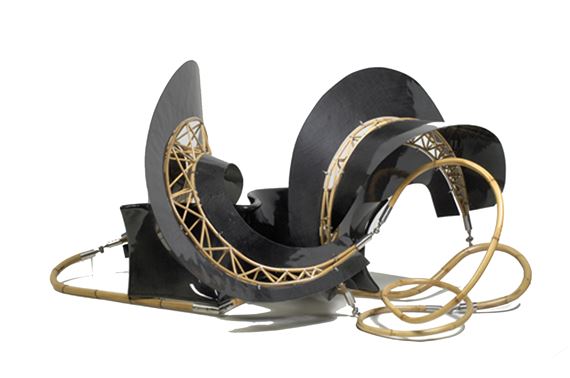X,Y,Z
Los Angeles, CA (March 2019) ŌĆō Mixografia is pleased to announce X,Y,Z, an exhibition that highlights MixografiaŌĆÖs collaborations with artists who have utilized the workshopŌĆÖs on-site foundry, fabrication, and mold making capabilities in the production of sculptural editions. The exhibition includes sculptural works by Karel Appel, Jonathan Borofsky, Donald Lipski, Henry Moore, Mimmo Paladino, and Frank Stella. There will be an opening reception on Saturday, March 23rd, 2019 from 4:00PM ŌĆō 6:00PM. The gallery is located at 1419 East Adams Boulevard, Los Angeles, CA 90011.
Mimmo Paladino interrupts conventions of printmaking in his California Suite, a series of eleven Mixografia prints. While maintaining a commitment to the mediumŌĆÖs essential qualities, as a means of reproducing an image using ink on paper, the artist expands his compositions to include sculptural elements and layered multimedia assemblages. PaladinoŌĆÖs second collaboration with Mixografia is a monumental image of a human figure set beneath a cluster of cast-resin black birds fastened to the surface, further pushing the printŌĆÖs dimensional space outward. The artistŌĆÖs methods of material experimentation, and his exploration of symbolic tropes, solidify him as an eminent figure of the Transavantgarde, a movement among artists working in Italy and much of Western Europe throughout the 1970s and 1980s as a response to postwar abstraction. Using simplified representations of the human form in combination with industrial materials, Paladino connects mythology, metaphor, and symbolism to the modern condition.
Frank StellaŌĆÖs Bamboo Trophy II occupies its own space in the exhibition. The curvilinear sculpture in the round is an assemblage of carbon fiber and resin wings suspended by an interconnected framework of bamboo and metal supports. The geometric lattices uniting the jet-black fins follow a continuous line toward an interwoven tangle of bamboo tendrils. These parts are attached to each other by hinges that suggest the object has a range of kinetic motion, yet the object remains in stasis on its supporting surface.

Recommended for you
Los Angeles, CA (March 2019) ŌĆō Mixografia is pleased to announce X,Y,Z, an exhibition that highlights MixografiaŌĆÖs collaborations with artists who have utilized the workshopŌĆÖs on-site foundry, fabrication, and mold making capabilities in the production of sculptural editions. The exhibition includes sculptural works by Karel Appel, Jonathan Borofsky, Donald Lipski, Henry Moore, Mimmo Paladino, and Frank Stella. There will be an opening reception on Saturday, March 23rd, 2019 from 4:00PM ŌĆō 6:00PM. The gallery is located at 1419 East Adams Boulevard, Los Angeles, CA 90011.
Mimmo Paladino interrupts conventions of printmaking in his California Suite, a series of eleven Mixografia prints. While maintaining a commitment to the mediumŌĆÖs essential qualities, as a means of reproducing an image using ink on paper, the artist expands his compositions to include sculptural elements and layered multimedia assemblages. PaladinoŌĆÖs second collaboration with Mixografia is a monumental image of a human figure set beneath a cluster of cast-resin black birds fastened to the surface, further pushing the printŌĆÖs dimensional space outward. The artistŌĆÖs methods of material experimentation, and his exploration of symbolic tropes, solidify him as an eminent figure of the Transavantgarde, a movement among artists working in Italy and much of Western Europe throughout the 1970s and 1980s as a response to postwar abstraction. Using simplified representations of the human form in combination with industrial materials, Paladino connects mythology, metaphor, and symbolism to the modern condition.
Frank StellaŌĆÖs Bamboo Trophy II occupies its own space in the exhibition. The curvilinear sculpture in the round is an assemblage of carbon fiber and resin wings suspended by an interconnected framework of bamboo and metal supports. The geometric lattices uniting the jet-black fins follow a continuous line toward an interwoven tangle of bamboo tendrils. These parts are attached to each other by hinges that suggest the object has a range of kinetic motion, yet the object remains in stasis on its supporting surface.

 ARTISTS
ARTISTS












